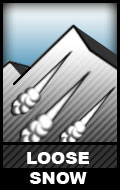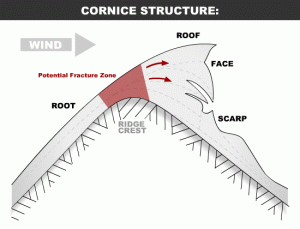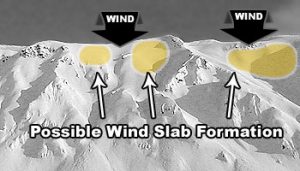Avalanche Danger Forecast
Issued Thursday, March 4, 2021 at noon for the greater Anchorage area Western Chugach Mountains (i.e. Chugach State Park). View map of primary forecast area here.
Avalanche danger is expected to fluctuate within the moderate spectrum this weekend: increasing Friday due to snow and wind then decreasing Saturday and Sunday due to relatively uneventful weather.
On Friday and Saturday fresh, soft wind slabs on leeward terrain (primarily west to north aspects) in the upper elevations will be the primary avalanche problem.
Winds are forecast to shift Saturday and become northerly. This will keep fresh, soft wind slabs as the primary avalanche problem but necessitate being mindful of their development on different aspects (east to south).
Persistent slabs remain a lower probability, but higher consequence, concern. They are most likely on steep, especially convex and/or unsupported, terrain in the mid to upper elevations in areas of the park with a thinner and weaker snowpack and on shadier, colder northerly aspects where the temperature gradient has promoted a weakening metamorphism (faceting) of the snowpack.
Sluffs and cornice falls are additional concerns to keep in mind.
Mountain Weather:
Friday: light snow developing, temps in the 20s, moderate east to south wind
Saturday: cloudy with a chance of snow early then decreasing clouds later, temps in the low 20s to teens, light to moderate northerly wind (watch for stronger NW wind in areas more exposed to outflow)
Sunday: decreasing clouds, temps in the teens to low 20s, light to moderate northerly wind (watch for stronger NW wind in areas more exposed to outflow)
Discussion:
Chugach State Park snow and riding conditions have been excellent in recent days: the best in the region.
A few to several inches of new snow Friday into Saturday is expected to further improve the already great surface and riding conditions, although snowfall and clouds will make for low visibility thus hampering mountain endeavors until clearing begins later Saturday.
The weather and surface conditions look promising for Saturday afternoon and Sunday.
In terms of the rain crust observed in the southeastern Front Range and Turnagain Arm area last Sunday, it was not found in the upper South Fork Eagle River area Wednesday. While it was found in the Rabbit Creek area of the Front Range Tuesday, it didn’t negatively affect riding conditions due to it being subtle and on top of firm and supportable wind-packed snow. In the Rabbit Creek area Tuesday, the rain crust was not observed to be exacerbating wind slab and sluffing avalanche problems from the few inches of new snow received Monday.
We are not aware of the extent of the rain crust beyond the areas mentioned above, and how it is affecting avalanche problems if it does exist in other areas of the park. Where it does exist, expect it to potentially adversely affect riding conditions if it has much soft snow below it (as it’s not supportable) in addition to exacerbating instabilities due to it serving as a weak interface or low friction bed surface. As a relatively impermeable layer, it will also exacerbate faceting above and below it due to its negative effect on the temperature gradient.
Surface hoar developed on the snow surface in many areas from the clear skies with light winds of recent days. While surface hoar in the primary forecast area is usually dismantled by wind before it’s buried and becomes a problem, there’s a chance it could get buried intact in some areas and become a reactive persistent weak layer.
Avalanche Problems:
 Wind slabs up to D2 in size above 2500′ on leeward terrain steeper than 35º.
Wind slabs up to D2 in size above 2500′ on leeward terrain steeper than 35º.
Wind will shift through the forecast period and due to the terrain of the park channeling winds in varying directions, watch for small wind slabs on all aspects.
Active wind loading, recent avalanches, and shooting cracks are red flag indicators of wind slab danger. Wind slabs are most likely to exist below corniced areas and along the lee sides of ridges and cross-loaded features like gullies:
Relatively densely-packed (firm and “punchier” feeling) snow and pockets of deeper snow (especially with a bulbous or fat appearance) are indicators of wind slabs. If you look closely at the snow surface you may be able to distinguish where wind slabs exist due to the snow having a more textured, densely-packed, consolidated, cohesive, and/or striated appearance. Be especially wary of (and avoid) steep, convex, and/or unsupported wind loaded terrain features.
Pole probing and hand pits are a quick and effective means of assessing this problem as you travel. Use pole probing to quickly feel out areas of denser, wind-packed snow overlying looser and weaker snow. Use hand pits to quickly assess how near-surface layers of snow are bonded.
Digging a snowpit and conducting a compression test and/or extended column test will provide an even better assessment of bonding and instability before you travel on terrain of consequence.
You can also assess wind slab instability via safer “test slopes” that are representative of higher consequence terrain.
Persistent slabs up to D2.5 in size above 2500′ on terrain steeper than 35º.
While persistent slabs may exist on all aspects, expect the problem to be the most pronounced in areas with a generally thinner and weaker snowpack as well as on shadier and colder northerly aspects (where the temperature gradient is relatively adverse to bonding and stabilization of buried persistent weak layers).
The persistent slab problem is lower probability, but potentially much higher consequence, than the wind slab problem. Persistent slabs triggered this forecast period may be hard slabs that break deeper down in the snowpack and release above and around a human trigger (rather than at the trigger’s feet) which can make escape difficult. Hard slab avalanche debris is also more likely to cause trauma than debris from soft slabs.
Be on the lookout for red flag warnings of persistent slab danger: recent avalanches, collapsing (aka “whumphing“), and shooting cracks.
Diverse and widespread persistent weak layers exist in the snowpack. Faceted snow exists above and below crusts in some areas, sandwiched between wind packed layers in many areas, and a basal weak layer of advanced facets and depth hoar is widespread. Surface hoar may also exist in isolated areas.
 Dry loose snow avalanches (human triggered sluffing and naturally triggered spindrift) are possible above 3000′ on steep terrain (38º+) across all aspects.
Dry loose snow avalanches (human triggered sluffing and naturally triggered spindrift) are possible above 3000′ on steep terrain (38º+) across all aspects.
While these relatively small avalanches (D1) aren’t much of a concern in regard to burial, they do have the potential to cause a fall or loss of control. While not likely, it’s possible that a loose snow avalanche could trigger a larger wind or persistent slab as it descends a slope.
Don’t let a loose snow avalanche catch you off guard. Manage your sluff if descending via ski or snowboard steep and wind-sheltered terrain with loose and uncohesive snow. If it’s windy and you’re climbing steep and/or exposed terrain, be mindful of the potential for heavy spindrift that could knock you off your feet and take you for a (potentially deadly) ride.
Cornices are large and overhanging in some areas above 2500′. New snow and wind will make them more prone to failure and falling.
Give cornices a wide berth and don’t approach the edge of a ridge to look down slope unless you’re sure it’s not corniced. Cornices can break off further back than expected (even beyond the true edge of the mountain ridge beneath the snow surface). In addition to the danger of taking a nasty fall due to a collapsing cornice, a falling cornice may “bomb” the slope it lands on and trigger an avalanche.
Terrain management is always the best way to deal with avalanche problems: eliminate or reduce your exposure to terrain capable of producing an avalanche. Before traveling on or under terrain that has the potential to avalanche think about the consequences and have a plan (to escape the avalanche, for re-grouping, and rescue).
Always be mindful of terrain traps that can make even a small avalanche deadly.
Click the hyperlinks and icons to learn more.
Please let us know what you’re seeing by tagging us on Instagram @anchorage_avalanche_center, submitting an observation, sending an email to info@anchorageavalanchecenter.org, or via FaceBook message. All observations help us provide a better forecast product (no matter how basic). We can keep your observation confidential, and only use the information to inform forecast products.




